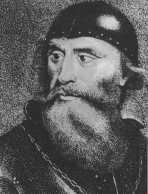William Wallace

In his short 35 year life, Wallace made a major contribution to Scotland's freedom and independence from England.
Wallace is believed to have been born around 1270, either at Elderslie, Renfrewshire, or at Ellerslie, near Kilmarnock. He is thought to have been the son of Sir Malcolm Wallace, a knight and small landowner.
As a boy, Wallace was sent to live with his uncle in Stirlingshire, who instilled him with stories about Scottish freedom. Relations between England and Scotland had been amicable until Edward I took the English throne in 1272 and inaugurated 250 years of bitter hatred and warfare. In 1286, Alexander III of Scotland died. There were many claimants to the throne, and the Scottish nobles foolishly requested Edward's arbitration. He cleverly compelled them all to recognise his overlordship of Scotland before pronouncing John Balliol king in 1292. But Edward's insistence on having the final say in Scottish cases eventually provoked the Scottish nobles to force Balliol to ally with France.
Edward conquered Scotland in 1296, taking the Stone of Destiny on which Scottish kings were crowned to Westminster. Balliol abdicated, and Edward decided to rule the Scots himself.
This treatment and the outrages committed by English soldiers infuriated Wallace, who decided to rise up along with a gang of supporters. He was made an outlaw after stabbing to death the son of the governor of Dundee in 1291.
Wallace's first major act of resistance came when he sacked Lanark in 1297. He is said to have married Marion Braidfute, who lived in the town and bore him a daughter. English forces attempted to seize him and when he escaped, they murdered Marion. By way of revenge, Wallace returned to Lanark, decapitated the sheriff, and set fire to the house. The town's population rose up and the entire English garrison was forced out.
Wallace put together an army of commoners and small landowners and attacked 500 English soldiers at Ayr. He then seized Glasgow and marched on Scone, before moving North. As Scotland's nobles started to embrace Wallace's cause, Edward responded by sending 40,000 men north. The two sides met at Cambuskenneth, where the Scots declared their freedom was not negotiable. The result was that, on September 11, 1297, the English tried to push across the narrow Stirling Bridge on the Forth. Wallace, who had only 16,000 men, had two major advantages. Firstly, he commanded the high ground, and secondly, the bridge would only take horse riders two abreast. As the army began to cross in numbers, Wallace's forces charged and secured the bridgehead. The battle lasted barely an hour, and more than 5000 English died. The victory led to Wallace being appointed Guardian of Scotland. He then marched South to Newcastle, often matching the brutality which the English forces had shown the Scots.
Furious Edward swore revenge and put together a massive army of 100,000 footmen and 8000 horsemen while Wallace withdrew North.
The two armies were to meet at Falkirk where the outnumbered Scots were utterly defeated, and Wallace fled to France to unsuccessfully seek help.
Wallace returned to Scotland in 1303 but it had become a treacherous place for him, especially since Edward had placed a bounty of 300 merks on his head. Inevitably, he was betrayed. He was seized by a Scots baron, John Monteith, taken to Dumbarton Castle, then moved to London under heavy guard.
On August 23, 1305, Wallace was tried for treason. In an impassioned statement, Wallace rejected this, pointing out he had never accepted Edward as king. "I cannot be a traitor," he said, "for I owe him no allegiance. He is not my sovereign; he never received my homage."
Wallace was found guilty, condemned and dragged through the streets of London. He was subjected to the most sadistic and brutal tortures before finally being beheaded.
His head was then placed on a pole on London Bridge, and his body cut into quarters and sent to Berwick, Newcastle, Perth and Aberdeen.
It was an inglorious end, but by then Wallace's place in history as one of the great men of Scotland had been assured.

Highlands of Scotland Menu...
Please sign our Guestbook